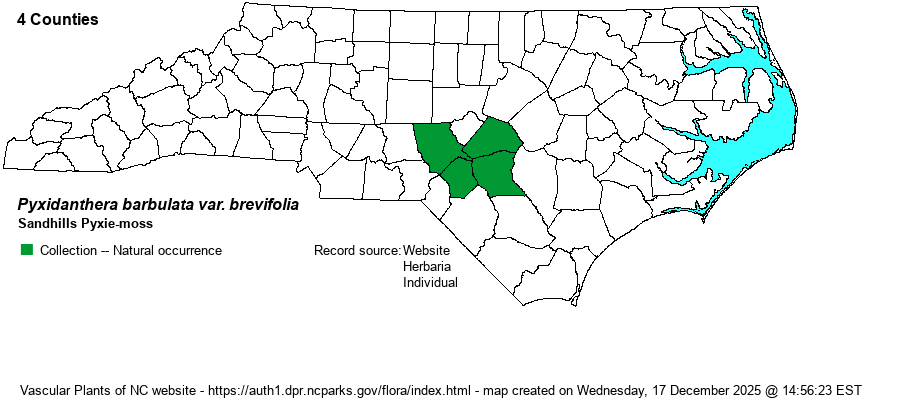| Author | (B.W. Wells) Ahles | |
| Distribution | Found only in the Sandhills region, and within that area it has yet to be found in the southern counties of Richmond or Scotland; found only in Moore, Harnett, Hoke, and Cumberland counties. A record for Brunswick County is suspect. Note that BONAP lists this as a full species -- P. brevifolia, but Weakley (2020) keeps it as a variety.
This is a very narrow endemic, found only in NC and adjacent SC, all in the Sandhills region.
| |
| Abundance | Very restricted in range, but it is fairly common on Fort Bragg and not hard to find. Rare away from Fort Bragg, and mysteriously absent (so far) from the extensive Sandhills Game Land, which seems to have suitable habitat. Two suspect populations at SGL were checked again in 2021 and confirmed as nominate barbulata. This is a State Threatened taxon in the state. Note that the official State status on the Plant Conservation Program 2021 list has it as a full species -- P. brevifolia. | |
| Habitat | The taxon is restricted to sandy soil on clay hardpans within the Sandhills region, typically on ridges and hilltops. It is also found over “paint rock” (i.e., very thin soil with sandstone rock beneath) in upland sandhills. It is not found in moist habitats, nor in deep sands of Carolina bay rims. | |
| Phenology | Blooms from February into March, rarely as early as December; one of our earliest blooming “shrubs”. Fruits from February to May. | |
| Identification | This is a tiny sub-shrub with narrow evergreen leaves, resembling a moss. It grows essentially flat on the ground, but as it grows in dense stands, it can occur in mounds that can easily be kicked loose by unobservant hikers. Colonies can extend for several feet across. The tiny leaves are needle-like, barely 1/8-inch long, densely covering the stems. At times the plants can have a reddish tint, especially where desiccated or in very dry conditions. The white flowers (about 1/4-inch across), though quite small, are so abundant that the plants looks like patches of snow when in bloom. The very similar var. barbulata, grows in moist to wet soil of flatwoods, pocosin borders, or savannas, as opposed to thin sandy soil on hilltops, ridges, or over a hardpan. Its leaves are somewhat larger and are seldom reddish-tinged, but the two can be confused at times. You have to be extremely observant if you want to spot this species, and likely you will need to go down to your knees or your belly to get a convincing look. | |
| Taxonomic Comments | The 2 Pyxie-moss taxa have been considered as full species, varieties, or fully lumped by various authors. Weakley (2020) weighs the evidence and treats them as varieties, though BONAP and NatureServe (and thus the NCNHP) has them as separate species.
| |
| Other Common Name(s) | Wells’s Pyxie-moss, Littleleaf Pyxie-moss, Little Pyxie | |
| State Rank | S2 | |
| Global Rank | G3 | |
| State Status | T | |
| US Status | | |
| USACE-agcp | | |
| USACE-emp | | |

